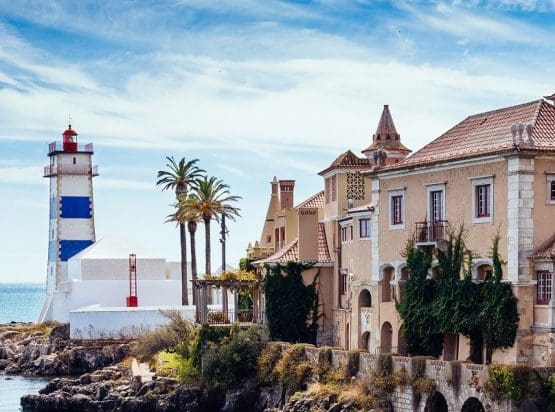Uncover Cascais's vibrant flavors and culinary gems with our expert guides. Plan an unforgettable trip now!
Read more
EXPLORE ALL OUR GUIDES TO PORTUGAL'S WINE REGIONS
Last updated: November 27, 2023
At the mouth of the Tagus, where Portuguese explorers set sail for South America, there is a world of esoteric flavors to discover. Yet, until recently, this part of the Portuguese landscape was scarcely given a second thought. This is particularly ironic, as Bucelas was one of the favored suppliers of Victorian England in the 19th century – regions like Alentejo were given over to wheat and sheep farming. Nevertheless, this tiny DO shrank to obscurity in the 1900s while sommeliers and buyers were busy rediscovering the Douro and Vinho Verde.
However, as the international market for saline white wines has exploded over the past five years, interest in the ‘vineyards of Lisbon’ has also dramatically risen. After a period of stagnation, Bucelas is a hot topic in the wine bars of Portugal’s sophisticated capital – exports are also growing in Europe and Brazil. The region’s specialty is Arinto: it produces aromatic and racy wine reminiscent of a good Riesling. Moreover, even the best bottles can be drunk with pleasure when young, although top labels gain enormously in character by keeping. And, slowly but surely, these qualities are being discovered abroad. But, of course, there is immense competition to manage, not least from Bucelas’ neighbors. What will stand the region in good stead, however, is its talented winemakers and growing tourism. Seventeen million visitors set foot in Lisbon in 2022. That makes for a lot of wine ambassadors when they return home.

Lisbon is fortunate to have a wealth of exceptional terroirs on its doorstep, a natural advantage that has been exploited since the days of the Romans. After they defeated the Carthaginian general Hannibal in 202 BC, the Romans soon appropriated the most valuable piece of real estate in Western Europe: the Iberian Peninsula. Establishing their hegemony in 216 BC, the Romans called this vast landscape Hispania, although the land between the Douro and Tagus rivers was known as Lusitania. Named after the Celtiberian tribe that occupied what became modern-day Portugal, the Romans inevitably subjugated the Celtiberians during their long reign. Their principal gift to the discerning middle classes was wine growing; viticulture thrived in the hills surrounding Lisbon for centuries. But Roman wines would be almost unrecognizable today – they were sweet, strong, and frequently ‘cooked’ over flames to create the most potent concoction the world has ever known.
However, after the Western Roman Empire disintegrated in the 5th century, Lisbon’s wine industry was put on hiatus. A succession of barbarian invasions – Sarmatians, Alans, and Vandals – failed to conquer the territory, while the Germanic Suebi could only maintain control until 585. After that, the Visigoths attempted to build a lasting legacy, fortifying the settlement of Ulishbona (Lisbon) against further attack. Yet the disorganized forces of King Roderic offered little resistance to the mighty armies of the Tariq, who landed his Moorish invasion fleet in 711. Swiftly conquering most of the peninsula, the Moors held on to Lisbon until 1147, when it was recaptured by Afonso Henriques (with the help of English mercenaries). Thus began Portugal’s golden age: glorious prosperity dawned as Vasco de Gama and his contemporaries sailed across the globe. By the 16th century, Bucelas supplied the court of Elizabeth I with fortified wine known as ‘Charneco’ – it is mentioned in Shakespeare’s play Henry VI. However, it evolved into a non-fortified white style after Bucelas caught the eye of Arthur Wellesley, 1st Duke of Wellington.
Following his Portuguese campaign during the Peninsular War, Wellesley imported vast quantities of Bucelas wines, quaffed in the company of Queen Victoria! Such was the renown of this zesty white that it was given the sobriquet ‘Portugal’s Hock.’ Sadly, rapid urban development and declining economic prosperity saw the land under vine shrink considerably in the 20th century. But trust the Portuguese to turn things around: a revival movement is underway as growers respond to shifting tastes and the rising popularity of indigenous grapes. For the moment, Bucelas is in safe hands.
In the 20th century, vineyards planted in Lisbon’s ‘backyard’ were part of the Estremadura region, a strip of land flanked by the Tagus and the imposing majesty of the Serra Montejunto hills. Yet the catch-all term Estremadura is no longer used, as winegrowers increasingly emphasize points of difference rather than homogeneity. A recent development (in the wider area) is the reincarnation of the ubiquitous variety Castelão. Once derided as acidic plonk, Castelão is now being used to make very fresh and Burgundy-inspired red wine – crisp and crunchy. This is the new face of Portuguese exports, and consumers love it.
The vineyards are situated north of Lisbon – day trips are obligatory if you visit this wonderful city. Bucelas, meanwhile, has a temperate climate that is the envy of all southern Europeans; vineyards benefit from cooling coastal breezes that are a daily occurrence in the Atlantic-influenced climate of Bucelas. “As a historical and renowned designation of origin, it is a place of excellence for Arinto grape variety,” says Diogo Sepúlveda, head winemaker responsible for Sogrape wines in Bucelas.
“The soils are predominantly composed of limestone (white) rock origin, combining perfectly with the high Atlantic influence (foggy mornings, high amplitude of temperatures, cool and humid winds from the coast). The result is a slow ripening and high natural acidity of the grapes, essential to the profile of our wines.” Indeed, the appellation’s key strength is aromatic still whites: this is the ideal place to ripen berries slowly, achieving that wonderful balance between acid and fruit. The best sparkling blends, however, are no less fine.
The Bucelas DO was created at the beginning of the 20th century, in 1911. Yet, despite the considerable passage of time, the framework remains the same. Bucelas is a straightforward appellation for the production of white wines, still and sparkling. As a result, most producers market their labels as Bucelas DO, unlike many growers in Alentejo, for example. According to the DO rules, the most-planted white grape, Arinto, must account for three-quarters of the final blend. Occasionally, winegrowers add a certain percentage of Rabo de Ovelha and/or Sercial to enhance structure and mouthfeel. But Arinto is always the driving force in local whites. The finest sparkling wines, meanwhile, are always made via the traditional method.
Ultimately, winemaking in Bucelas is relatively unremarkable. Most growers seek aromatic finesse and the purity of expression that flows from unoaked white wines. Therefore, most wineries embrace a protective winemaking paradigm:
Maturation on the fine lees is sometimes used to add richness and depth to the wine. Yet the market demands fresh, perfumed whites with brilliant fruitiness and clean flavors.
According to the late geographer Harm de Blij, viticulture and urbanization are “both allies and adversaries.” Indeed, vineyards that spread out in all directions from the capital offer a topical case study of the ongoing tensions between urban development and traditional wine growing. Certain land owners, lured by the promise of easy money, have sold their estates to property developers on both sides of the Tagus. On the other hand, there is enormous pressure to build more homes in Portugal due to a massive shortage of affordable housing stock. And we cannot deny that providing more houses for younger people and families is a noble aim.
But there is an equally strong argument for keeping regions like Bucelas alive. There is a case for expanding the area under vine rather than curtailing it. As producers worldwide grapple with global warming, the shift towards cooler climate viticulture can only rise. Bucelas’ gift to oenologists is its proximity to the Atlantic: the ocean provides a natural barrier to excessive heat during the summer season. This enables growers to slowly ripen their crop without sacrificing acid at the altar of phenolic ripeness. Winemakers in the hotter parts of Alentejo would give their right arm for such conditions. Before too long, some may uproot and join the Bucelas revival story.
Arinto is a versatile white wine grape variety known for its crisp acidity, citrus, green apple flavors, and a mineral finish
Find out moreRabo de Ovelha produces full-bodied, aromatic wines with tropical fruit, apricot, and honey flavors. This rare grape is known for its high sugar content and is often used in sweet wine production. Despite its name, which translates to "sheep's tail," Rabo de Ovelha produces elegant and complex wines that pair well with desserts, cheeses, and spicy dishes.
Sercial is a grape variety traditionally grown on the island of Madeira, known for producing high-quality dry wines with a pale, golden color and pronounced acidity. With aromas of green apple, lime, and nutmeg, Sercial wines are crisp and refreshing, with a distinctive saline character that pairs well with seafood and sushi.
Food and dining out is a religion in Portugal, especially in Lisbon’s bustling, dynamic capital. Many visitors to Bucelas elect to have their main meal in Lisbon – understandable, as the city is rammed with exceptional restaurants that cater to all budgets. From pastéis de bacalhau (savory codfish pastries) to the iconic custard treats, Portugal is a paradise for the discerning gastronome. As you would expect, freshly caught seafood features heavily in local cuisine: grilled sardines will be served everywhere, from rustic haunts to Michelin-starred venues. Fried cuttlefish, bouillabaisse, langoustines, and crab are also major highlights. Suffice it to say all the best wine lists are found in Lisbon.

Uncover Cascais's vibrant flavors and culinary gems with our expert guides. Plan an unforgettable trip now!
Read more
Uncover Lisbon's vibrant flavors and culinary gems with our expert guides. Plan an unforgettable trip now!
Read more
Uncover Sintra's vibrant flavors and culinary gems with our expert guides. Plan an unforgettable trip now!
Read moreIf you would like us to customize an exclusive luxury tour, contact us and let us know your travel plans. We offer luxury food and wine tours for private groups of a mininium two guests. In addition, all of our private, chauffeured tours are available year-round upon request.

